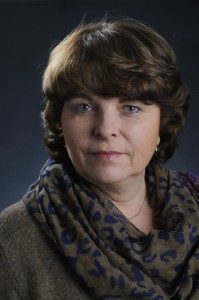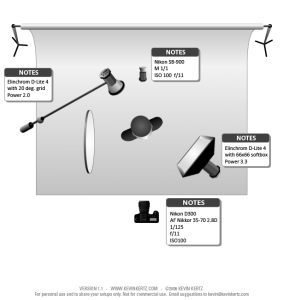Continuing with yesterday’s topic, here’s another example of a studio lighting setup. In fact, it is my standard setup for regular straightforward headshots. Noting fancy, but technically perfect lit images. If someone would call me in the middle of the night and ask me to do a photoshoot, this would be the setup I would use. I can set it up with my eyes closed.
It uses 3 strobes: 1 mainlight, 1 hairlight and 1 background light. For the first 2 I use my Elinchrome D-Lite 4’s. For the background light I use my Nikon SB900 flash unit. But equipped with a Skyport receiver, so it is triggered by the camera at the same time as the other two. For the hairlight I didn’t use a boom, but it more or less illustrates that the strobe is a bit higher than the softbox. As a matter of fact, my studio is located in the basement at home. One of the disadvantages is the limited height. For this setup the strobe touches the ceiling (about 2.20 metres/7+ feet). Distance between the model and the mainlight and the hairlight is about 2.5 feet/75 cm. Distance from model to the background is 1.5 metres/5 feet.
The background light nicely separates the model from the background. I like the little bit of light on the model’s shoulder coming from the hairlight. In general, I think it’s a very good shot from a technical perspective. At the same time, it doesn’t say much about the character of the model. I have quoted Duane Michals on this blog before, but I thinks he’s spot on:
“It takes no great powers or magic to reproduce somebody’s face in a photograph. The magic is in seeing people in new ways.”
So the real challenge is to take a portrait that tells you (as a viewer) something about the person’s character. Have a look inside, if you like. Lighting is an important (if not crucial) element in this. So you do need to understand how it works and the effect it can have on the image. And therefore, on you as viewer.

